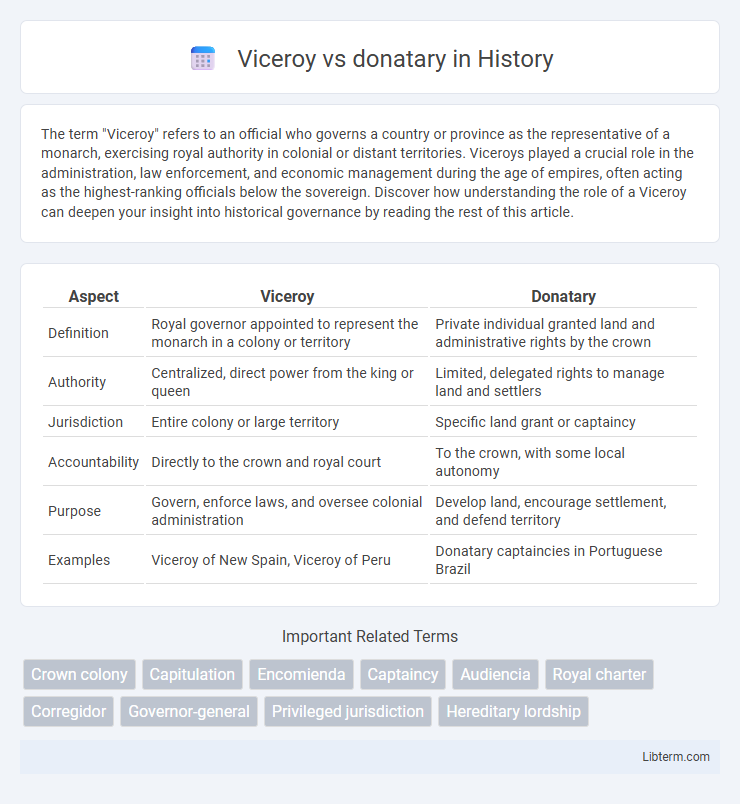The term "Viceroy" refers to an official who governs a country or province as the representative of a monarch, exercising royal authority in colonial or distant territories. Viceroys played a crucial role in the administration, law enforcement, and economic management during the age of empires, often acting as the highest-ranking officials below the sovereign. Discover how understanding the role of a Viceroy can deepen your insight into historical governance by reading the rest of this article.
Table of Comparison
| Aspect | Viceroy | Donatary |
|---|---|---|
| Definition | Royal governor appointed to represent the monarch in a colony or territory | Private individual granted land and administrative rights by the crown |
| Authority | Centralized, direct power from the king or queen | Limited, delegated rights to manage land and settlers |
| Jurisdiction | Entire colony or large territory | Specific land grant or captaincy |
| Accountability | Directly to the crown and royal court | To the crown, with some local autonomy |
| Purpose | Govern, enforce laws, and oversee colonial administration | Develop land, encourage settlement, and defend territory |
| Examples | Viceroy of New Spain, Viceroy of Peru | Donatary captaincies in Portuguese Brazil |
Introduction: Viceroy and Donatary Defined
A viceroy is a high-ranking official appointed by a monarch to govern a territory on their behalf, often wielding extensive administrative and military powers. A donatary refers to an individual granted a land donation, typically in colonial settings, with authority to administer and develop the land under specific conditions. Both roles exemplify colonial governance structures but differ in the scope and nature of their delegated powers.
Historical Origins of Viceroys and Donataries
Viceroys originated in the 15th century Iberian empires as royal representatives governing large territories with authority directly from the monarch, particularly in Spanish and Portuguese colonies. Donataries emerged from the Portuguese donatario system, where individuals were granted hereditary rights to administer and develop specified lands, primarily in Brazil and other colonial regions. Both roles originated as methods to extend monarchal control over distant territories, but viceroys held more centralized power, while donataries operated with semi-feudal autonomy.
Roles and Responsibilities Compared
Viceroys acted as the monarch's direct representatives, overseeing large territories with broad administrative, military, and judicial powers to enforce royal policies and maintain colonial order. Donataries, typically granted land by the crown in Portuguese colonies, held proprietary rights and were responsible for local governance, economic development, and defense within their donatarias but operated with more limited authority than viceroys. While viceroys exercised centralized control over extensive regions, donataries balanced autonomy with obligations to the crown, focusing on settlement promotion and resource management.
Geographic Domains: Where Each System Flourished
The Viceroy system thrived primarily in large colonial empires like New Spain and Peru, where vast and diverse geographic domains required centralized administration from Mexico City and Lima to manage territories spanning present-day Mexico, Central America, and much of South America. In contrast, the Donatary system flourished mainly in Portuguese colonies such as Brazil and parts of Africa, where the Crown granted specific territories to nobles known as donataries, who held hereditary rights to administer and develop these smaller, more distinct geographic areas. These differing geographic scopes reflect the Viceroy's role in governing expansive, multifaceted regions versus the Donatary's focus on localized, autonomous landholdings.
Appointment Processes: Selection and Tenure
Viceroys were typically appointed directly by the monarch, chosen for their loyalty and administrative expertise, and served for a fixed or indefinite tenure depending on royal directives. Donataries, on the other hand, were granted land and governing rights by the crown often as hereditary appointments or for life, emphasizing feudal ties and local autonomy. The appointment process for viceroys involved centralized royal approval, whereas donataries operated under more decentralized and hereditary succession systems.
Political Authority and Administrative Powers
Viceroys exercised political authority as direct representatives of the monarch, governing large colonial territories with extensive administrative powers including law enforcement, military command, and tax collection. Donataries held delegated authority over specific land grants or captaincies, combining territorial jurisdiction with economic privileges but often with more limited and localized administrative powers. The viceroyalty structure centralized governance under royal oversight, while donatary systems allowed more autonomous, proprietary control within their designated regions.
Economic Functions and Fiscal Authority
Viceroys acted as the king's direct representatives, overseeing extensive economic functions such as managing royal revenues, trade regulations, and resource allocations within their territories. Donataries held more localized fiscal authority, responsible for collecting taxes and promoting economic development in their granted lands but had limited powers compared to viceroys. The viceroy's role typically included broader economic oversight and enforcement of royal fiscal policies, while donataries focused on regional administration and economic exploitation.
Influence on Colonial Governance
Viceroys exerted direct royal authority and centralized governance through appointed officials in vast colonial territories, ensuring strict adherence to the crown's policies. Donataries wielded semi-autonomous power, managing land grants with considerable local governance freedom, fostering a more decentralized colonial administration. The contrast between viceroyalties and donataries shaped distinct governance models influencing legal frameworks, economic control, and political stability in colonial empires.
Legacy and Long-term Impact
Viceroys governed large territories on behalf of monarchs, establishing centralized administrative systems that influenced colonial governance and legal frameworks for centuries. Donataries, often granted hereditary control over smaller regions, shaped localized economic development and social hierarchies through extended family rule. The legacy of viceroys is evident in the lasting state institutions, while donataries impacted regional cultures and landownership patterns across colonial empires.
Conclusion: Viceroy vs Donatary—Key Differences
Viceroys acted as direct representatives of the monarch, governing large territories with comprehensive administrative, judicial, and military authority. Donataries held delegated rights over specific land grants, primarily focusing on local land management and economic development while maintaining allegiance to the crown. The key difference lies in the scope of power, with viceroys wielding broader sovereign authority and donataries functioning more as feudal landholders under royal oversight.
Viceroy Infographic

 libterm.com
libterm.com